Abstract
OBJECTIVES: This study examined factors influencing return to work (RTW) following severe fracture to a lower extremity. METHODS: This prospective cohort study followed 312 individuals treated for a lower extremity fracture at 3 level-1 trauma centers. Kaplan-Meier estimates of the proportion of RTW were computed, and a Cox proportional hazards model was used to examine the contribution of multiple risk factors on RTW. RESULTS: Cumulative proportions of RTW at 3, 6, 9, and 12 months post-injury were 0.26, 0.49, 0.60, and 0.72. After accounting for the extent of impairment, characteristics of the patient that correlated with higher rates of RTW included younger age, higher education, higher income, the presence of strong social support, and employment in a white-collar job that was not physically demanding. Receipt of disability compensation had a strong negative effect on RTW. CONCLUSIONS: Despite relatively high rates of recovery, one quarter of persons with lower extremity fractures did not return to work by the end of 1 year. The analysis points to subgroups of individuals who are at high risk of delayed RTW, with implications for interventions at the patient, employer, and policy levels.
Full text
PDF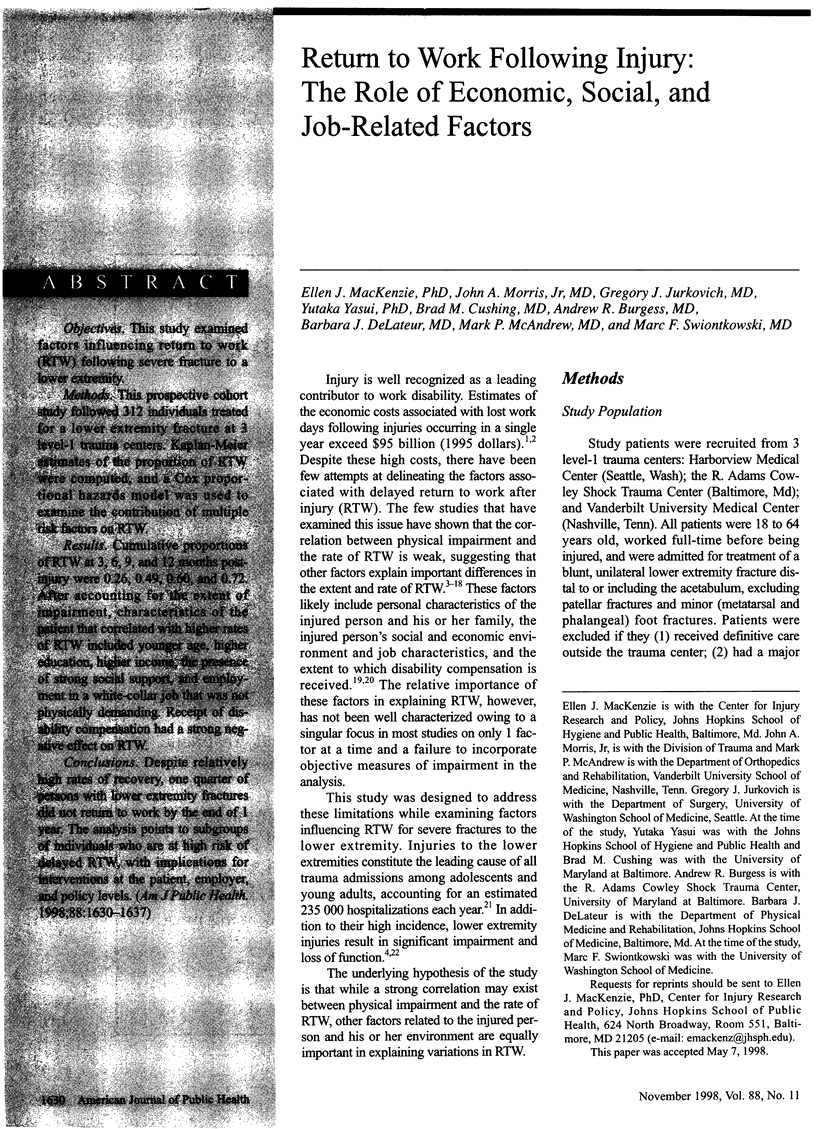
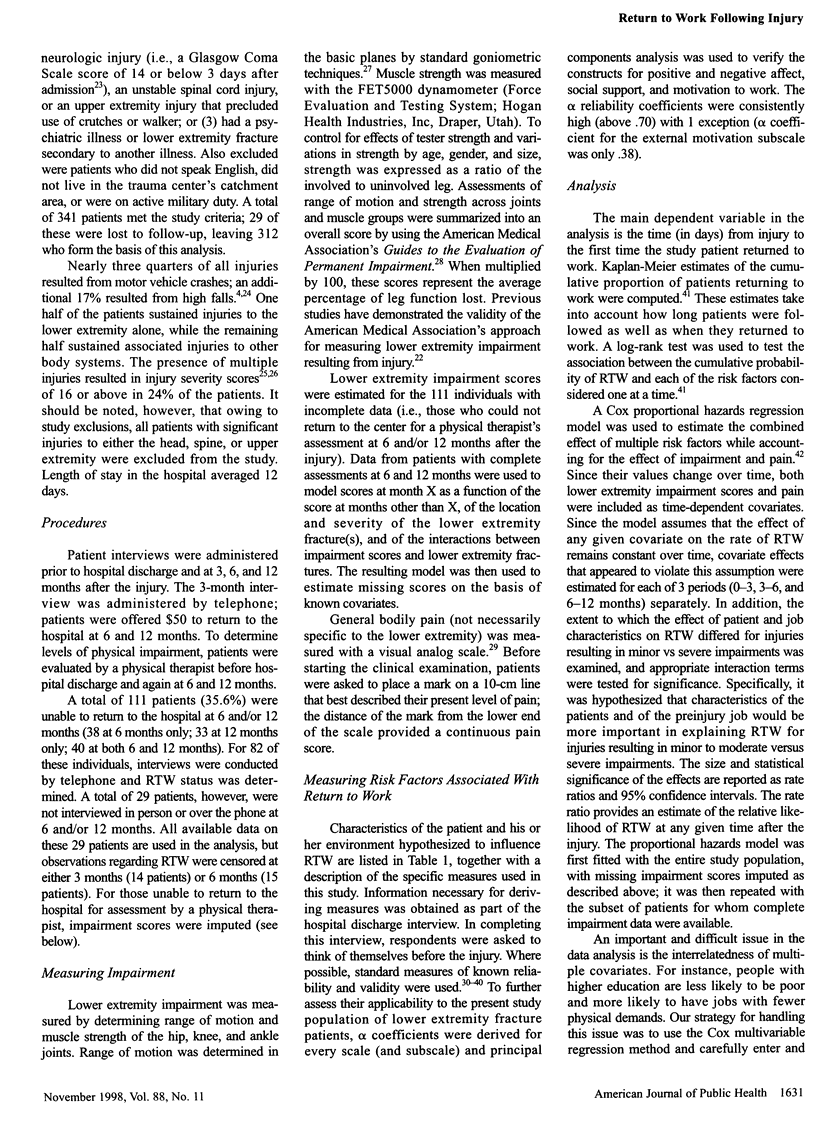
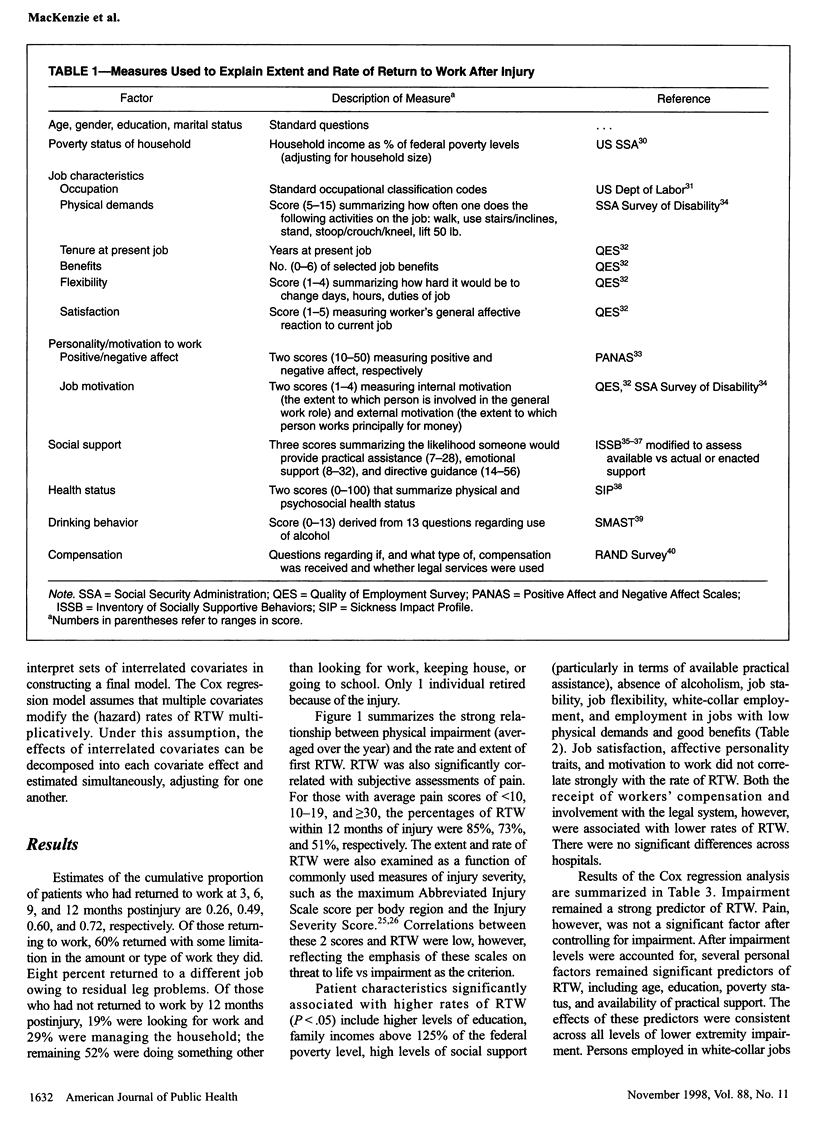
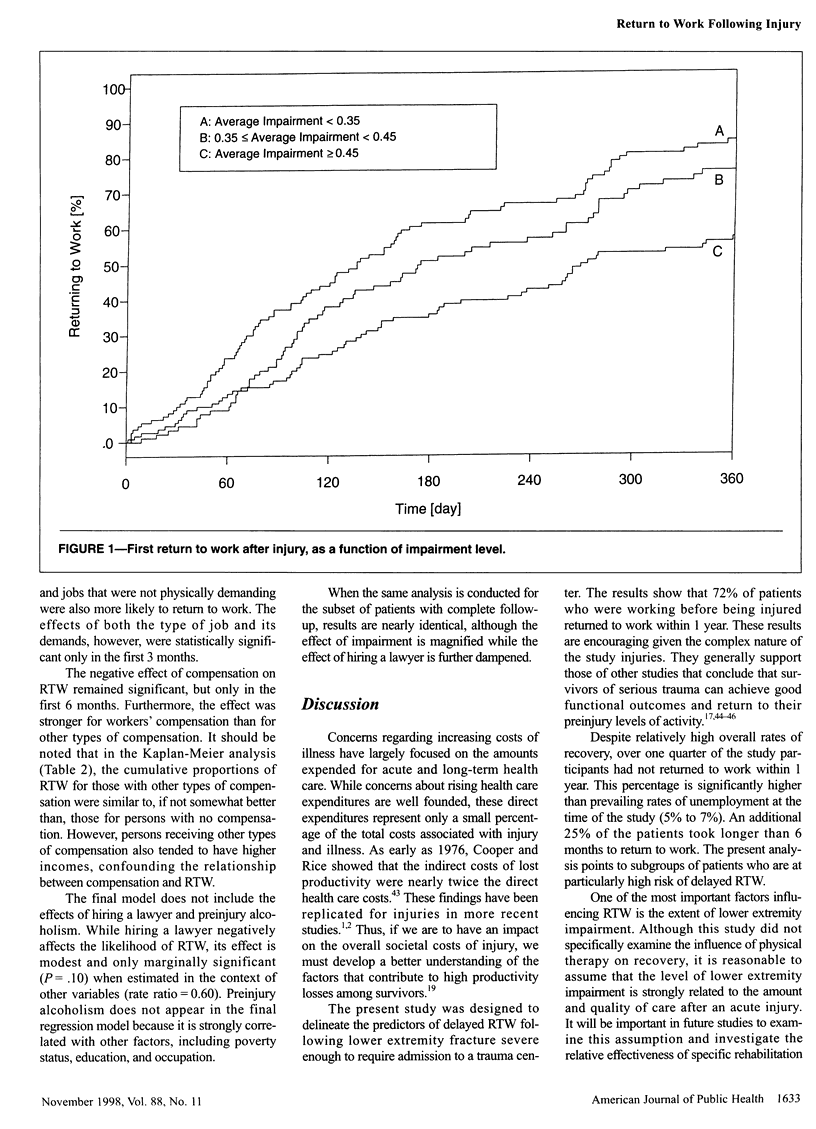

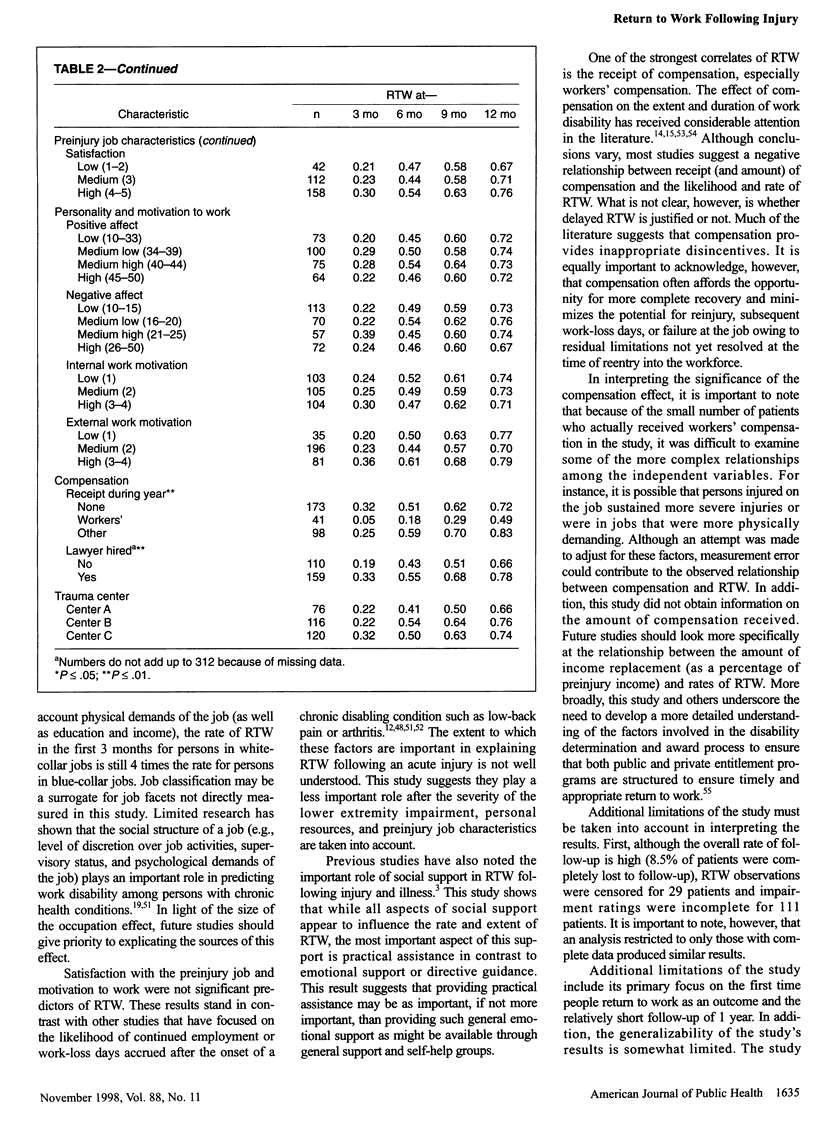


Selected References
These references are in PubMed. This may not be the complete list of references from this article.
- Alexander D., Mangelsdorff A. D. Screening alcohol abuse potential among Army reservists with the Short Michigan Alcoholism Screening Test. Mil Med. 1994 Sep;159(9):595–600. [PubMed] [Google Scholar]
- Baker S. P., O'Neill B., Haddon W., Jr, Long W. B. The injury severity score: a method for describing patients with multiple injuries and evaluating emergency care. J Trauma. 1974 Mar;14(3):187–196. [PubMed] [Google Scholar]
- Barrera M., Jr, Ainlay S. L. The structure of social support: a conceptual and empirical analysis. J Community Psychol. 1983 Apr;11(2):133–143. doi: 10.1002/1520-6629(198304)11:2<133::aid-jcop2290110207>3.0.co;2-l. [DOI] [PubMed] [Google Scholar]
- Bergner M., Bobbitt R. A., Carter W. B., Gilson B. S. The Sickness Impact Profile: development and final revision of a health status measure. Med Care. 1981 Aug;19(8):787–805. doi: 10.1097/00005650-198108000-00001. [DOI] [PubMed] [Google Scholar]
- Brewin C. R., Robson M. J., Shapiro D. A. Social and psychological determinants of recovery from industrial injuries. Injury. 1983 Mar;14(5):451–455. doi: 10.1016/0020-1383(83)90097-9. [DOI] [PubMed] [Google Scholar]
- Brooks N., McKinlay W., Symington C., Beattie A., Campsie L. Return to work within the first seven years of severe head injury. Brain Inj. 1987 Jul-Sep;1(1):5–19. doi: 10.3109/02699058709034439. [DOI] [PubMed] [Google Scholar]
- Cats-Baril W. L., Frymoyer J. W. Identifying patients at risk of becoming disabled because of low-back pain. The Vermont Rehabilitation Engineering Center predictive model. Spine (Phila Pa 1976) 1991 Jun;16(6):605–607. doi: 10.1097/00007632-199106000-00001. [DOI] [PubMed] [Google Scholar]
- Cheadle A., Franklin G., Wolfhagen C., Savarino J., Liu P. Y., Salley C., Weaver M. Factors influencing the duration of work-related disability: a population-based study of Washington State workers' compensation. Am J Public Health. 1994 Feb;84(2):190–196. doi: 10.2105/ajph.84.2.190. [DOI] [PMC free article] [PubMed] [Google Scholar]
- Cooper B. S., Rice D. P. The economic cost of illness revisited. Soc Secur Bull. 1976 Feb;39(2):21–36. [PubMed] [Google Scholar]
- Cornes P. Return to work of road accident victims claiming compensation for personal injury. Injury. 1992;23(4):256–260. doi: 10.1016/s0020-1383(05)80011-7. [DOI] [PubMed] [Google Scholar]
- DeVivo M. J., Rutt R. D., Stover S. L., Fine P. R. Employment after spinal cord injury. Arch Phys Med Rehabil. 1987 Aug;68(8):494–498. [PubMed] [Google Scholar]
- Dikmen S. S., Temkin N. R., Machamer J. E., Holubkov A. L., Fraser R. T., Winn H. R. Employment following traumatic head injuries. Arch Neurol. 1994 Feb;51(2):177–186. doi: 10.1001/archneur.1994.00540140087018. [DOI] [PubMed] [Google Scholar]
- Frymoyer J. W., Cats-Baril W. Predictors of low back pain disability. Clin Orthop Relat Res. 1987 Aug;(221):89–98. [PubMed] [Google Scholar]
- Greenough C. G., Fraser R. D. The effects of compensation on recovery from low-back injury. Spine (Phila Pa 1976) 1989 Sep;14(9):947–955. doi: 10.1097/00007632-198909000-00006. [DOI] [PubMed] [Google Scholar]
- Holbrook T. L., Hoyt D. B., Anderson J. P., Hollingsworth-Fridlund P., Shackford S. R. Functional limitation after major trauma: a more sensitive assessment using the Quality of Well-being scale--the trauma recovery pilot project. J Trauma. 1994 Jan;36(1):74–78. [PubMed] [Google Scholar]
- Jurkovich G., Mock C., MacKenzie E., Burgess A., Cushing B., deLateur B., McAndrew M., Morris J., Swiontkowski M. The Sickness Impact Profile as a tool to evaluate functional outcome in trauma patients. J Trauma. 1995 Oct;39(4):625–631. doi: 10.1097/00005373-199510000-00001. [DOI] [PubMed] [Google Scholar]
- Krause J. S. Employment after spinal cord injury. Arch Phys Med Rehabil. 1992 Feb;73(2):163–169. [PubMed] [Google Scholar]
- Lehmann T. R., Spratt K. F., Lehmann K. K. Predicting long-term disability in low back injured workers presenting to a spine consultant. Spine (Phila Pa 1976) 1993 Jun 15;18(8):1103–1112. doi: 10.1097/00007632-199306150-00023. [DOI] [PubMed] [Google Scholar]
- MacKenzie E. J., Cushing B. M., Jurkovich G. J., Morris J. A., Jr, Burgess A. R., deLateur B. J., McAndrew M. P., Swiontkowski M. F. Physical impairment and functional outcomes six months after severe lower extremity fractures. J Trauma. 1993 Apr;34(4):528–539. doi: 10.1097/00005373-199304000-00009. [DOI] [PubMed] [Google Scholar]
- MacKenzie E. J., Shapiro S., Smith R. T., Siegel J. H., Moody M., Pitt A. Factors influencing return to work following hospitalization for traumatic injury. Am J Public Health. 1987 Mar;77(3):329–334. doi: 10.2105/ajph.77.3.329. [DOI] [PMC free article] [PubMed] [Google Scholar]
- Mather J. H. The problem of functional assessment: political and economic perspectives. Am J Occup Ther. 1993 Mar;47(3):240–246. doi: 10.5014/ajot.47.3.240. [DOI] [PubMed] [Google Scholar]
- Maurette P., Masson F., Nicaud V., Cazaugade M., Garros B., Tiret L., Thicoïpe M., Erny P. Posttraumatic disablement: a prospective study of impairment, disability, and handicap. J Trauma. 1992 Nov;33(5):728–736. [PubMed] [Google Scholar]
- McCarthy M. L., McAndrew M. P., MacKenzie E. J., Burgess A. R., Cushing B. M., Delateur B. J., Jurkovich G. J., Morris J. A., Swiontkowski M. F. Correlation between the measures of impairment, according to the modified system of the American Medical Association, and function. J Bone Joint Surg Am. 1998 Jul;80(7):1034–1042. doi: 10.2106/00004623-199807000-00012. [DOI] [PubMed] [Google Scholar]
- Morris J. A., Jr, Sanchez A. A., Bass S. M., MacKenzie E. J. Trauma patients return to productivity. J Trauma. 1991 Jun;31(6):827–834. doi: 10.1097/00005373-199106000-00014. [DOI] [PubMed] [Google Scholar]
- Mudrick N. R. Predictors of disability among midlife men and women: differences by severity of impairment. J Community Health. 1988 Summer;13(2):70–84. doi: 10.1007/BF01364202. [DOI] [PubMed] [Google Scholar]
- Rimel R. W., Giordani B., Barth J. T., Boll T. J., Jane J. A. Disability caused by minor head injury. Neurosurgery. 1981 Sep;9(3):221–228. [PubMed] [Google Scholar]
- Rivara F. P., Gurney J. G., Ries R. K., Seguin D. A., Copass M. K., Jurkovich G. J. A descriptive study of trauma, alcohol, and alcoholism in young adults. J Adolesc Health. 1992 Dec;13(8):663–667. doi: 10.1016/1054-139x(92)90060-o. [DOI] [PubMed] [Google Scholar]
- Scott J., Huskisson E. C. Graphic representation of pain. Pain. 1976 Jun;2(2):175–184. [PubMed] [Google Scholar]
- Selzer M. L., Vinokur A., van Rooijen L. A self-administered Short Michigan Alcoholism Screening Test (SMAST). J Stud Alcohol. 1975 Jan;36(1):117–126. doi: 10.15288/jsa.1975.36.117. [DOI] [PubMed] [Google Scholar]
- Sheikh K. Return to work following limb injuries. J Soc Occup Med. 1985 Winter;35(4):114–117. doi: 10.1093/occmed/35.4.114. [DOI] [PubMed] [Google Scholar]
- Smith G. R., Jr, O'Rourke D. F. Return to work after a first myocardial infarction. A test of multiple hypotheses. JAMA. 1988 Mar 18;259(11):1673–1677. [PubMed] [Google Scholar]
- Stokes J. P., Wilson D. G. The inventory of socially supportive behaviors: dimensionality, prediction, and gender differences. Am J Community Psychol. 1984 Feb;12(1):53–69. doi: 10.1007/BF00896928. [DOI] [PubMed] [Google Scholar]
- Tate D. G. Workers' disability and return to work. Am J Phys Med Rehabil. 1992 Apr;71(2):92–96. doi: 10.1097/00002060-199204000-00006. [DOI] [PubMed] [Google Scholar]
- Teasdale G., Jennett B. Assessment of coma and impaired consciousness. A practical scale. Lancet. 1974 Jul 13;2(7872):81–84. doi: 10.1016/s0140-6736(74)91639-0. [DOI] [PubMed] [Google Scholar]
- Walsh N. E., Dumitru D. The influence of compensation on recovery from low back pain. Occup Med. 1988 Jan-Mar;3(1):109–121. [PubMed] [Google Scholar]
- Watson D., Clark L. A., Tellegen A. Development and validation of brief measures of positive and negative affect: the PANAS scales. J Pers Soc Psychol. 1988 Jun;54(6):1063–1070. doi: 10.1037//0022-3514.54.6.1063. [DOI] [PubMed] [Google Scholar]
- Weighill V. E. 'Compensation neurosis': a review of the literature. J Psychosom Res. 1983;27(2):97–104. doi: 10.1016/0022-3999(83)90085-5. [DOI] [PubMed] [Google Scholar]
- Yelin E. H., Henke C. J., Epstein W. V. Work disability among persons with musculoskeletal conditions. Arthritis Rheum. 1986 Nov;29(11):1322–1333. doi: 10.1002/art.1780291104. [DOI] [PubMed] [Google Scholar]
- Yelin E., Nevitt M., Epstein W. Toward an epidemiology of work disability. Milbank Mem Fund Q Health Soc. 1980 Summer;58(3):386–415. [PubMed] [Google Scholar]
- van der Sluis C. K., ten Duis H. J., Geertzen J. H. Multiple injuries: an overview of the outcome. J Trauma. 1995 May;38(5):681–686. doi: 10.1097/00005373-199505000-00001. [DOI] [PubMed] [Google Scholar]


